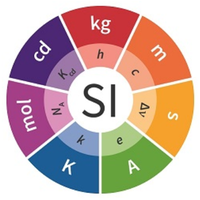Difference between revisions of "Template:Base quantities and count"
From Bioblast
| Line 1: | Line 1: | ||
[[File:SI-units.png|right|200px|link=https://www.bipm.org/utils/common/pdf/si-brochure/SI-Brochure-9-EN.pdf]] | |||
::::: {| class="wikitable" | ::::: {| class="wikitable" | ||
|- | |- | ||
| Line 13: | Line 14: | ||
| thermodynamic temperature || ''T'' || Θ || kelvin || K | | thermodynamic temperature || ''T'' || Θ || kelvin || K | ||
|- | |- | ||
| [[amount]] of substance<sup>*</sup> || ''n'' || N || mole || mol | | [[amount]] of substance <sup>*</sup> || ''n'' || N || mole || mol | ||
|- | |- | ||
| [[count]]<sup>*, | | [[count]] <sup>*,§</sup> || ''N'' || C || counting unit || x | ||
|- | |- | ||
| luminous intensity || ''I''<sub>v</sub> || J || candela || cd | | luminous intensity || ''I''<sub>v</sub> || J || candela || cd | ||
|} | |} | ||
:::: <sup>*</sup> For the quantities ''n'' and ''N'', the entities X have to be specified in the text or indicated by a subscript or in parentheses | :::: <sup>*</sup> For the quantities ''n'' and ''N'', the entities X have to be specified in the text or indicated by a subscript or in parentheses: ''n''<sub>X</sub>; ''N''<sub>X</sub>. | ||
:::: <sup> | :::: <sup>§</sup> '[[Count]]' is synonymous with 'number of entities'; the name, symbol and unit are not included in the SI as a base quantity or base unit. | ||
Revision as of 05:23, 17 May 2020
Base quantity Symbol for quantity Symbol for dimension Name of SI unit Symbol for SI unit length l L meter m mass m M kilogram kg time t T second s electric current I I ampere A thermodynamic temperature T Θ kelvin K amount of substance * n N mole mol count *,§ N C counting unit x luminous intensity Iv J candela cd
- * For the quantities n and N, the entities X have to be specified in the text or indicated by a subscript or in parentheses: nX; NX.
- § 'Count' is synonymous with 'number of entities'; the name, symbol and unit are not included in the SI as a base quantity or base unit.
